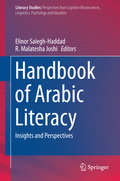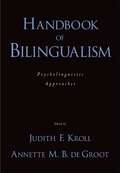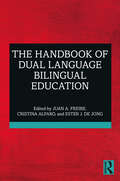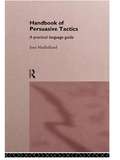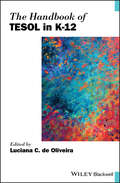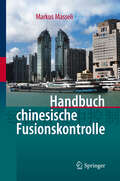- Table View
- List View
Handbook for Arabic Language Teaching Professionals in the 21st Century, Volume II
by Kassem M. Wahba Liz England Zeinab A. TahaDrawing on the collective expertise of language scholars and educators in a variety of subdisciplines, the Handbook for Arabic Language Teaching Professionals in the 21st Century, Volume II, provides a comprehensive treatment of teaching and research in Arabic as a second and foreign language worldwide. Keeping a balance among theory, research and practice, the content is organized around 12 themes: Trends and Recent Issues in Teaching and Learning Arabic Social, Political and Educational Contexts of Arabic Language Teaching and Learning Identifying Core Issues in Practice Language Variation, Communicative Competence and Using Frames in Arabic Language Teaching and Learning Arabic Programs: Goals, Design and Curriculum Teaching and Learning Approaches: Content-Based Instruction and Curriculum Arabic Teaching and Learning: Classroom Language Materials and Language Corpora Assessment, Testing and Evaluation Methodology of Teaching Arabic: Skills and Components Teacher Education and Professional Development Technology-Mediated Teaching and Learning Future Directions The field faces new challenges since the publication of Volume I, including increasing and diverse demands, motives and needs for learning Arabic across various contexts of use; a need for accountability and academic research given the growing recognition of the complexity and diverse contexts of teaching Arabic; and an increasing shortage of and need for quality of instruction. Volume II addresses these challenges. It is designed to generate a dialogue—continued from Volume I—among professionals in the field leading to improved practice, and to facilitate interactions, not only among individuals but also among educational institutions within a single country and across different countries.
Handbook for Arabic Language Teaching Professionals in the 21st Century, Volume II
by Kassem M. Wahba Liz England Zeinab A. TahaDrawing on the collective expertise of language scholars and educators in a variety of subdisciplines, the Handbook for Arabic Language Teaching Professionals in the 21st Century, Volume II, provides a comprehensive treatment of teaching and research in Arabic as a second and foreign language worldwide. Keeping a balance among theory, research and practice, the content is organized around 12 themes: Trends and Recent Issues in Teaching and Learning Arabic Social, Political and Educational Contexts of Arabic Language Teaching and Learning Identifying Core Issues in Practice Language Variation, Communicative Competence and Using Frames in Arabic Language Teaching and Learning Arabic Programs: Goals, Design and Curriculum Teaching and Learning Approaches: Content-Based Instruction and Curriculum Arabic Teaching and Learning: Classroom Language Materials and Language Corpora Assessment, Testing and Evaluation Methodology of Teaching Arabic: Skills and Components Teacher Education and Professional Development Technology-Mediated Teaching and Learning Future Directions The field faces new challenges since the publication of Volume I, including increasing and diverse demands, motives and needs for learning Arabic across various contexts of use; a need for accountability and academic research given the growing recognition of the complexity and diverse contexts of teaching Arabic; and an increasing shortage of and need for quality of instruction. Volume II addresses these challenges. It is designed to generate a dialogue—continued from Volume I—among professionals in the field leading to improved practice, and to facilitate interactions, not only among individuals but also among educational institutions within a single country and across different countries.
Handbook of Arabic Literacy: Insights and Perspectives (Literacy Studies #9)
by Elinor Saiegh-Haddad R. Malatesha JoshiThis book provides a synopsis of recently published empirical research into the acquisition of reading and writing in Arabic. Its particular focus is on the interplay between the linguistic and orthographic structure of Arabic and the development of reading and writing/spelling. In addition, the book addresses the socio-cultural, political and educational milieu in which Arabic literacy is embedded. It enables readers to appreciate both the implications of empirical research to literacy enhancement and the challenges and limitations to the applicability of such insights in the Arabic language and literacy context. The book will advance the understanding of the full context of literacy acquisition in Arabic with the very many factors (religious, historical, linguistic etc.) that interact and will hence contribute to weakening the anglocentricity that dominates discussions of this topic.
Handbook of Bilingualism: Psycholinguistic Approaches
by Judith F. Kroll, Annette M. B. De GrootHow is language acquired when infants are exposed to multiple language input from birth and when adults are required to learn a second language after early childhood? How do adult bilinguals comprehend and produce words and sentences when their two languages are potentially always active and in competition with one another? What are the neural mechanisms that underlie proficient bilingualism? What are the general consequences of bilingualism for cognition and for language and thought? This handbook will be essential reading for cognitive psychologists, linguists, applied linguists, and educators who wish to better understand the cognitive basis of bilingualism and the logic of experimental and formal approaches to language science.
Handbook of Bilingualism: Psycholinguistic Approaches
by Judith F. Kroll Annette M. B. De GrootHow is language acquired when infants are exposed to multiple language input from birth and when adults are required to learn a second language after early childhood? How do adult bilinguals comprehend and produce words and sentences when their two languages are potentially always active and in competition with one another? What are the neural mechanisms that underlie proficient bilingualism? What are the general consequences of bilingualism for cognition and for language and thought? This handbook will be essential reading for cognitive psychologists, linguists, applied linguists, and educators who wish to better understand the cognitive basis of bilingualism and the logic of experimental and formal approaches to language science.
The Handbook of Chinese Linguistics (Blackwell Handbooks in Linguistics)
by C.-T. James Huang Y.-H. Audrey Li Andrew SimpsonThe Handbook of Chinese Linguistics is the first comprehensive introduction to Chinese linguistics from the perspective of modern theoretical and formal linguistics. Containing twenty-five chapters, the book offers a balanced, accessible and thoughtfully organized introduction to some of the most important results of research into Chinese linguistics carried out by theoretical linguists during the last thirty years. Presenting critical overviews of a wide range of major topics, it is the first to meet the great demand for an overview volume on core areas of Chinese linguistics.Authoritative contributions describe and assess the major achievements and controversies of research undertaken in each area, and provide bibliographies for further reading. The contributors refer both to their own work in relevant fields, and objectively present a range of competitor theories and analyses, resulting in a volume that is fully comprehensive in its coverage of theoretical research into Chinese linguistics in recent years. This unique Handbook is suitable both as a primary reader for structured, taught courses on Chinese linguistics at university level, and for individual study by graduates and other professional linguists.
The Handbook of Chinese Linguistics (Blackwell Handbooks in Linguistics)
by C. T. James Huang Y. H. Audrey Li Andrew SimpsonThe Handbook of Chinese Linguistics is the first comprehensive introduction to Chinese linguistics from the perspective of modern theoretical and formal linguistics. Containing twenty-five chapters, the book offers a balanced, accessible and thoughtfully organized introduction to some of the most important results of research into Chinese linguistics carried out by theoretical linguists during the last thirty years. Presenting critical overviews of a wide range of major topics, it is the first to meet the great demand for an overview volume on core areas of Chinese linguistics.Authoritative contributions describe and assess the major achievements and controversies of research undertaken in each area, and provide bibliographies for further reading. The contributors refer both to their own work in relevant fields, and objectively present a range of competitor theories and analyses, resulting in a volume that is fully comprehensive in its coverage of theoretical research into Chinese linguistics in recent years. This unique Handbook is suitable both as a primary reader for structured, taught courses on Chinese linguistics at university level, and for individual study by graduates and other professional linguists.
The Handbook of Dual Language Bilingual Education
by Juan A. Freire Cristina Alfaro de Jong, Ester JThis handbook presents a state-of-the-art overview of dual language bilingual education (DLBE) research, programs, pedagogy, and practice. Organized around four sections—theoretical foundations; key issues and trends; school-based practices; and teacher and administrator preparation—the volume comprehensively addresses major and emerging topics in the field. With contributions from expert scholars, the handbook highlights programs that honor the assets of language-minoritized and marginalized students and provides empirically grounded guidance for asset-based instruction. Chapters cover historical and policy considerations, leadership, family relations, professional development, community partnerships, race, class, gender, and more. Synthesizing major issues, discussing central themes and advancing policy and practice, this handbook is a seminal volume and definitive reference text in bilingual/second language education.
The Handbook of Dual Language Bilingual Education
This handbook presents a state-of-the-art overview of dual language bilingual education (DLBE) research, programs, pedagogy, and practice. Organized around four sections—theoretical foundations; key issues and trends; school-based practices; and teacher and administrator preparation—the volume comprehensively addresses major and emerging topics in the field. With contributions from expert scholars, the handbook highlights programs that honor the assets of language-minoritized and marginalized students and provides empirically grounded guidance for asset-based instruction. Chapters cover historical and policy considerations, leadership, family relations, professional development, community partnerships, race, class, gender, and more. Synthesizing major issues, discussing central themes and advancing policy and practice, this handbook is a seminal volume and definitive reference text in bilingual/second language education.
The Handbook of English for Specific Purposes (Blackwell Handbooks in Linguistics #120)
by Brian Paltridge Sue StarfieldFeaturing a collection of newly commissioned essays, edited by two leading scholars, this Handbook surveys the key research findings in the field of English for Specific Purposes (ESP). • Provides a state-of-the-art overview of the origins and evolution, current research, and future directions in ESP • Features newly-commissioned contributions from a global team of leading scholars • Explores the history of ESP and current areas of research, including speaking, reading, writing, technology, and business, legal, and medical English • Considers perspectives on ESP research such as genre, intercultural rhetoric, multimodality, English as a lingua franca and ethnography
The Handbook of English for Specific Purposes (Blackwell Handbooks in Linguistics #123)
by Brian Paltridge Sue StarfieldFeaturing a collection of newly commissioned essays, edited by two leading scholars, this Handbook surveys the key research findings in the field of English for Specific Purposes (ESP). • Provides a state-of-the-art overview of the origins and evolution, current research, and future directions in ESP • Features newly-commissioned contributions from a global team of leading scholars • Explores the history of ESP and current areas of research, including speaking, reading, writing, technology, and business, legal, and medical English • Considers perspectives on ESP research such as genre, intercultural rhetoric, multimodality, English as a lingua franca and ethnography
Handbook of Heritage, Community, and Native American Languages in the United States: Research, Policy, and Educational Practice
by Terrence G. Wiley Joy Kreeft Peyton Donna Christian Sarah Catherine K. MooreCo-published by the Center for Applied Linguistics Timely and comprehensive, this state-of-the-art overview of major issues related to heritage, community, and Native American languages in the United States, based on the work of noted authorities, draws from a variety of perspectives—the speakers; use of the languages in the home, community, and wider society; patterns of acquisition, retention, loss, and revitalization of the languages; and specific education efforts devoted to developing stronger connections with and proficiency in them. Contributions on language use, programs and instruction, and policy focus on issues that are applicable to many heritage language contexts. Offering a foundational perspective for serious students of heritage, community, and Native American languages as they are learned in the classroom, transmitted across generations in families, and used in communities, the volume provides background on the history and current status of many languages in the linguistic mosaic of U.S. society and stresses the importance of drawing on these languages as societal, community, and individual resources, while also noting their strategic importance within the context of globalization.
Handbook of Heritage, Community, and Native American Languages in the United States: Research, Policy, and Educational Practice
by Terrence G. Wiley Joy Kreeft Peyton Donna Christian Sarah Catherine K. Moore Na LiuCo-published by the Center for Applied Linguistics Timely and comprehensive, this state-of-the-art overview of major issues related to heritage, community, and Native American languages in the United States, based on the work of noted authorities, draws from a variety of perspectives—the speakers; use of the languages in the home, community, and wider society; patterns of acquisition, retention, loss, and revitalization of the languages; and specific education efforts devoted to developing stronger connections with and proficiency in them. Contributions on language use, programs and instruction, and policy focus on issues that are applicable to many heritage language contexts. Offering a foundational perspective for serious students of heritage, community, and Native American languages as they are learned in the classroom, transmitted across generations in families, and used in communities, the volume provides background on the history and current status of many languages in the linguistic mosaic of U.S. society and stresses the importance of drawing on these languages as societal, community, and individual resources, while also noting their strategic importance within the context of globalization.
Handbook of Literacy in Akshara Orthography (Literacy Studies #17)
by R. Malatesha Joshi Catherine McBrideThis volume examines the unique characteristics of akshara orthography and how they may affect literacy development and problems along with the implications for assessment and instruction. Even though akshara orthography is used by more than a billion people, there is an urgent need for a systematic attempt to bring the features, research findings, and future directions of akshara together in a coherent volume. We hope that this volume will bridge that gap. Akshara is used in several Indic languages, each calling it by a slightly different name, for example 'aksharamu', in Telugu, 'akshara' in Kannada, and 'akshar' in Hindi. It is the Bhrami-derived orthography used across much of the Indian subcontinent. There is a growing body of research on the psycholinguistic underpinnings of learning to read akshara, and the emerging perspective is that akshara, even though classified as alphasyllabaries, abugida, and semi-syllabic writing systems, is neither alphabetic nor syllabic. Rather, akshara orthography is unique and deserves to be a separate classification and needs further investigation relating to literacy acquisition in akshara. The chapters in this volume, written by leading authors in the field, will inform the reader of the current research on akshara in a coherent and systematic way.
A Handbook of Persuasive Tactics: A Practical Language Guide
by Joan MulhollandMost people have to communicate with colleagues every day and persuade them to understand their opinions or to accept their views. This handbook is intended for anyone who is interested in such goal-oriented language. It extracts 300 persuasive tactics from research findings in communication, linguistics, pragmatics and related fields, and presents them in a clear, concise and consistent manner. Such tactics as analogy, argument presentation, humour and metaphor are included. Each tactic is presented on a separate page with an analysis of its persuasive value. Two indexes - one by persuasive need and the other by tactic - allow readers full flexibility to use the handbook in their own way. This work should be of interest in courses which deal with the management of interaction, pragmatics, discourse analysis and communications.
A Handbook of Persuasive Tactics: A Practical Language Guide
by Joan MulhollandMost people have to communicate with colleagues every day and persuade them to understand their opinions or to accept their views. This handbook is intended for anyone who is interested in such goal-oriented language. It extracts 300 persuasive tactics from research findings in communication, linguistics, pragmatics and related fields, and presents them in a clear, concise and consistent manner. Such tactics as analogy, argument presentation, humour and metaphor are included. Each tactic is presented on a separate page with an analysis of its persuasive value. Two indexes - one by persuasive need and the other by tactic - allow readers full flexibility to use the handbook in their own way. This work should be of interest in courses which deal with the management of interaction, pragmatics, discourse analysis and communications.
Handbook of Research in Second Language Teaching and Learning: Volume III (ESL & Applied Linguistics Professional Series)
by Eli HinkelVolume III of the Handbook of Research in Second Language Teaching and Learning, like Volumes I and II, is a comprehensive, state-of-the-art overview of current research into social contexts of second language (L2)/foreign language (FL) teaching and learning; language policy; curriculum; types of instruction; incremental language skills such as listening, speaking, reading, writing, vocabulary, and grammar; international communication; pragmatics; assessment and testing. It differs from earlier volumes in its main purpose—to provide a more in-depth discussion and detailed focus on the development of the essential language skills required for any type of communication: speaking, listening, reading, vocabulary, grammar, and writing. Volume III preserves continuity with previous volumes in its coverage of all the classical areas of research in L2/FL teaching and learning and applied linguistics, but rather than offering a historical review of disciplinary traditions, it explores innovations and new directions of research, acknowledges the enormous complexity of teaching and learning the essential language abilities, and offers a diversity of perspectives. Chapter authors are all leading authorities in their disciplinary areas. What’s new in Volume III? Updates the prominent areas of research, including the sub-disciplines addressed in Volumes I and II, and represents the disciplinary mainstays Considers and discusses perspectives held by different schools of thought on the what, the how, and the why of teaching foundational language skills, including theories, pedagogical principles, and their implementation in practice Captures new and ongoing developments and trends in the key areas of L2/FL teaching and learning, and innovative research topics that have gained substantial recognition in current publications, including the role of corpora, technology, and digital literacy in L2/FL teaching and learning Examines new trends in language pedagogy and research, such as an increased societal emphasis on teaching academic language for schooling, somewhat contradictory definitions of literacy, and the growing needs for instruction in intercultural communication.
Handbook of Research in Second Language Teaching and Learning: Volume III (ESL & Applied Linguistics Professional Series)
by Eli HinkelVolume III of the Handbook of Research in Second Language Teaching and Learning, like Volumes I and II, is a comprehensive, state-of-the-art overview of current research into social contexts of second language (L2)/foreign language (FL) teaching and learning; language policy; curriculum; types of instruction; incremental language skills such as listening, speaking, reading, writing, vocabulary, and grammar; international communication; pragmatics; assessment and testing. It differs from earlier volumes in its main purpose—to provide a more in-depth discussion and detailed focus on the development of the essential language skills required for any type of communication: speaking, listening, reading, vocabulary, grammar, and writing. Volume III preserves continuity with previous volumes in its coverage of all the classical areas of research in L2/FL teaching and learning and applied linguistics, but rather than offering a historical review of disciplinary traditions, it explores innovations and new directions of research, acknowledges the enormous complexity of teaching and learning the essential language abilities, and offers a diversity of perspectives. Chapter authors are all leading authorities in their disciplinary areas. What’s new in Volume III? Updates the prominent areas of research, including the sub-disciplines addressed in Volumes I and II, and represents the disciplinary mainstays Considers and discusses perspectives held by different schools of thought on the what, the how, and the why of teaching foundational language skills, including theories, pedagogical principles, and their implementation in practice Captures new and ongoing developments and trends in the key areas of L2/FL teaching and learning, and innovative research topics that have gained substantial recognition in current publications, including the role of corpora, technology, and digital literacy in L2/FL teaching and learning Examines new trends in language pedagogy and research, such as an increased societal emphasis on teaching academic language for schooling, somewhat contradictory definitions of literacy, and the growing needs for instruction in intercultural communication.
The Handbook of TESOL in K-12 (Blackwell Handbooks in Linguistics)
by Luciana C. de OliveiraThe first handbook to explore the field of Teaching English to Speakers of Other Languages in elementary and secondary education (K-12) The number of students being educated in English has grown significantly in modern times — globalization, immigration, and evolving educational policies have prompted an increased need for English language learner (ELL) education. The Handbook of TESOL in K-12 combines contemporary research and current practices to provide a comprehensive overview of the origins, evolution, and future direction of Teaching English to Speakers of Other Languages at the elementary and secondary levels (K-12). Exploring the latest disciplinary and interdisciplinary issues in the field, this is a first-of-its-kind Handbook and contributions are offered from a team of internationally-renowned scholars. Comprehensive in scope, this essential Handbook covers topics ranging from bilingual language development and technology-enhanced language learning, to ESOL preparation methods for specialist and mainstream teachers and school administrators. Three sections organize the content to cover Key Issues in Teaching ESOL students in K-12, Pedagogical Issues and Practices in TESOL in K-12 Education, and School Personnel Preparation for TESOL in K-12. Satisfies a need for inclusive and in-depth research on TESOL in K-12 classrooms Presents a timely and interesting selection of topics that are highly relevant to working teachers and support staff Applies state-of-the-art research to real-world TESOL classroom settings Offers a balanced assessment of diverse theoretical foundations, concepts, and findings The Handbook of TESOL in K-12 is an indispensable resource for undergraduate and graduate students, researchers and scholars, and educators in the field of Teaching English to Speakers of Other Languages in elementary and secondary education.
The Handbook of TESOL in K-12 (Blackwell Handbooks in Linguistics)
by Luciana C. de OliveiraThe first handbook to explore the field of Teaching English to Speakers of Other Languages in elementary and secondary education (K-12) The number of students being educated in English has grown significantly in modern times — globalization, immigration, and evolving educational policies have prompted an increased need for English language learner (ELL) education. The Handbook of TESOL in K-12 combines contemporary research and current practices to provide a comprehensive overview of the origins, evolution, and future direction of Teaching English to Speakers of Other Languages at the elementary and secondary levels (K-12). Exploring the latest disciplinary and interdisciplinary issues in the field, this is a first-of-its-kind Handbook and contributions are offered from a team of internationally-renowned scholars. Comprehensive in scope, this essential Handbook covers topics ranging from bilingual language development and technology-enhanced language learning, to ESOL preparation methods for specialist and mainstream teachers and school administrators. Three sections organize the content to cover Key Issues in Teaching ESOL students in K-12, Pedagogical Issues and Practices in TESOL in K-12 Education, and School Personnel Preparation for TESOL in K-12. Satisfies a need for inclusive and in-depth research on TESOL in K-12 classrooms Presents a timely and interesting selection of topics that are highly relevant to working teachers and support staff Applies state-of-the-art research to real-world TESOL classroom settings Offers a balanced assessment of diverse theoretical foundations, concepts, and findings The Handbook of TESOL in K-12 is an indispensable resource for undergraduate and graduate students, researchers and scholars, and educators in the field of Teaching English to Speakers of Other Languages in elementary and secondary education.
Handbook To Biblical Hebrew: An Introductory Grammar
by Page H. Kelley Terry L. Burden Timothy G. CrawfordA Handbook to Biblical Hebrew: An Introductory Grammar
by Page H. Kelley Terry L. Burden Timothy G. CrawfordHandbuch chinesische Fusionskontrolle
by Markus Masseli, Dipl.-Kfm., LL.M.eurDas Handbuch ermöglicht eine Risikoeinschätzung geplanter Fusionen und dient als Argumentationshilfe und Anleitung für Fusionskontrollverfahren in China. Es orientiert sich an den für die Praxis maßgeblichen Gesichtspunkten und geht dabei auf die chinesische Fallpraxis und die Diskussion in der chinesischen Rechtsliteratur ein. Berücksichtigung finden auch die politischen und kulturellen Besonderheiten Chinas. Der Anhang enthält Übersetzungen der wichtigsten Rechtsvorschriften, juristischer Entscheidungen sowie Formulare.
Haunted Serbia: Representations of History and War in the Literary Imagination (Legenda)
by David NorrisHaunting is what happens when the past is disturbed and the victims of previous violence, who are thought to be buried and forgotten, are brought back to the present and made to live again. Serbian fiction writers of the 1980s exhume the ghosts of the past, re-remembering the cruelty of the twentieth century, reinterpreting the heroic role of the Partisans and the extraordinary measures taken to defend Yugoslavia’s recently won independence and socialist revolution. Their uncanny and ghostly imagery challenges the assumptions of the master discourse promoted by the country’s orthodox communist authorities and questions the historical roots of social and cultural identities. The instability of this period of transition is deepened during the wars of the 1990s, when authors turn from the memory of past violence to face the ferocious brutality of new conflicts. The haunting evocations in their work continue to articulate fresh uncertainties as the trappings of modern civilization are stripped away and replaced by the destructive logic of civil war. The past returns once more with renewed energy in the struggle to make sense of a vastly changed world.
Haunted Serbia: Representations of History and War in the Literary Imagination (Legenda)
by David NorrisHaunting is what happens when the past is disturbed and the victims of previous violence, who are thought to be buried and forgotten, are brought back to the present and made to live again. Serbian fiction writers of the 1980s exhume the ghosts of the past, re-remembering the cruelty of the twentieth century, reinterpreting the heroic role of the Partisans and the extraordinary measures taken to defend Yugoslavia’s recently won independence and socialist revolution. Their uncanny and ghostly imagery challenges the assumptions of the master discourse promoted by the country’s orthodox communist authorities and questions the historical roots of social and cultural identities. The instability of this period of transition is deepened during the wars of the 1990s, when authors turn from the memory of past violence to face the ferocious brutality of new conflicts. The haunting evocations in their work continue to articulate fresh uncertainties as the trappings of modern civilization are stripped away and replaced by the destructive logic of civil war. The past returns once more with renewed energy in the struggle to make sense of a vastly changed world.

